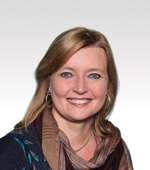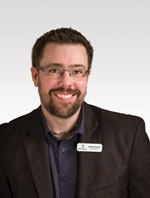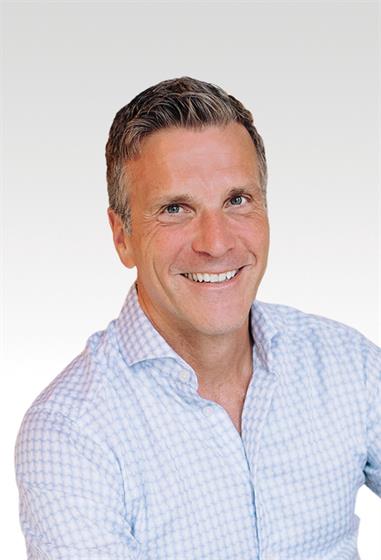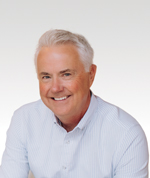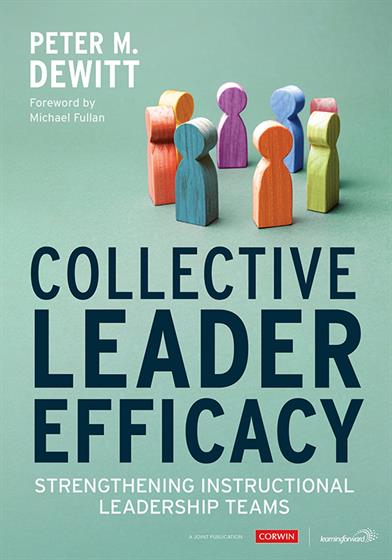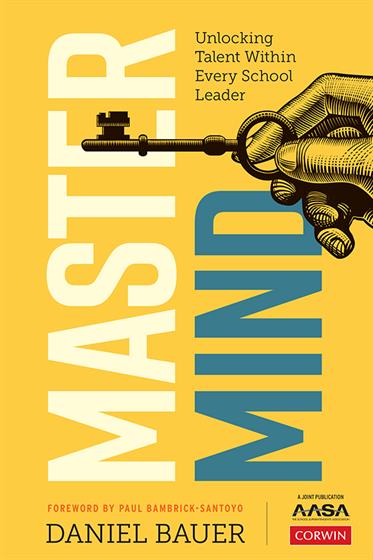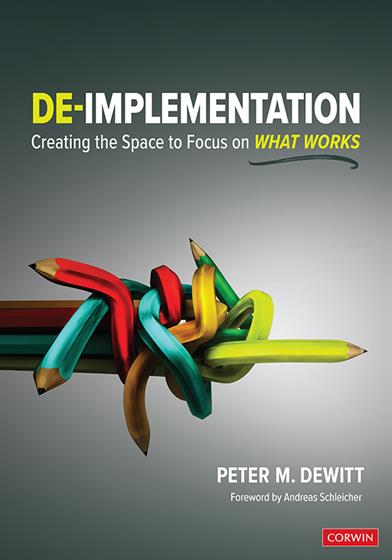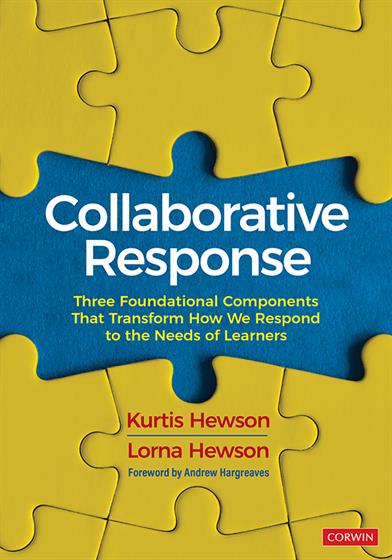Series 3 Leaders Coaching Leaders Podcast
[00:00:00.00] [MUSIC PLAYING]
[00:00:00.69] ANNOUNCER: Welcome to Corwin's Leaders Coaching Leaders podcast, with host Peter Dewitt. This podcast is from education leaders for education leaders. Every week, Peter and our guests get together to share ideas, put research into practice, and ensure every student is learning, not by chance, but by design.
[00:00:19.37] PETER DEWITT: Welcome to the Leaders Coaching Leaders podcast. And in this one, Tanya, I'm going to be talking to Kurtis and Lorna Hewson, from Alberta, Canada. They have a great new book out on collaborative response with Corwin. So it's such an interesting topic to talk about when it comes to collaboration because in many ways, people are going to think, is this really something new?
[00:00:44.13] We've been talking about collaboration for a while. But I think they are two people that actually have a lot of experience behind them and can offer something a little bit new.
[00:00:53.75] TANYA GHANS: Yeah, I completely agree. And what I really love is part of our theme is thinking about optimism. And especially, coming out of the time that we've all been dealing with COVID, it can be so hard to feel like there can be a new answer or a new response to something that's really challenging and difficult. And I think what the Hewsons offer is a way that schools can put in structures to continue to help people think outside of the box and look for solutions. And I think that's fantastic.
[00:01:25.95] PETER DEWITT: Yeah. And one thing listeners will definitely understand, is when we say we're focusing on theory and practice, but we're also focusing on optimism, these are two very optimistic people.
[00:01:37.02] TANYA GHANS: Very optimistic people, so get ready to really have a very pleasant conversation with our next two guests.
[00:01:44.70] [MUSIC PLAYING]
[00:01:48.44] ANNOUNCER: All right, welcome to Leaders Coaching Leaders podcast. Kurtis and Lorna Hewson, so glad to have you on here.
[00:01:56.79] LORNA HEWSON: We're thrilled to be here, Peter.
[00:01:58.82] KURTIS HEWSON: Honored. Thank you so much.
[00:02:01.02] PETER DEWITT: Congratulations on the new book that came out with Corwin in March of this year, which is Collaborative Response-- Three Foundational Components That Transform How We Respond to the Needs of Learners. That's great. Congratulations.
[00:02:16.19] KURTIS HEWSON: Thanks. Yeah, we're excited to be able to share the ideas and thoughts. And you take a look at a book, and I know that you have this experience, as well, of you look at the page count and whatnot. But the years and years that go in behind it, it's been 15 years in the making of learning, processing, and engaging with schools to be able to share some of the thoughts and ideas that come through. So really happy to have it out there.
[00:02:41.48] LORNA HEWSON: And so excited to be able to share the learning with others, too.
[00:02:46.07] PETER DEWITT: Of course. I'm glad that you said that, actually, because one of the things that I think people sometimes think is, you wake up in the morning, and you're like, hey, I'm going to write a book today. And in a couple of months, you publish it, and it's all good. But that's actually not the case. So before I ask you some nitty-gritty kind of questions, what actually inspired the two of you to write this book on collaborative response?
[00:03:11.90] KURTIS HEWSON: Well, it really starts about 16 years ago, of being in a school and seeing great teachers doing great things for kids. But it was in isolated pockets, and kids were falling through the cracks. And it was not due to individual ineptness or anything like that. It was structural. It was the way we were organizing ourselves to respond to the kids that we had in the building.
[00:03:40.99] So we started to put pieces in place and then started to see some success in school, started to come visit. And it was interesting. When you try and describe the complexities and the interconnections of the things that were happening, you'd see people's eyes glaze over. You needed a language.
[00:03:58.78] So we started to really build out a framework of, how could you explain this to somebody else? And then it led to self-publishing a book that was sold primarily in our province of Alberta, Canada, here where we reside. And then through that process of working with schools and then working with school divisions and learning, we just reached a point of our understanding of what we did in our own school is so rudimentary to where we are at now through the learning and the experiences of engaging and supporting others.
[00:04:35.85] So it really prompted us-- well, now, five to six years later from that self-published title, to put this one together, that still has some of the basic tenets that we were beginning to understand 16 years ago, but to a much greater level of depth and understanding, that could have only happened through working with amazing schools, school leaders, and system leaders.
[00:05:00.05] LORNA HEWSON: And really that organic growth from what we wanted to see happen within our own school to being able to share those ideas with others-- but we need to preface that we made lots of mistakes along the way.
[00:05:15.41] KURTIS HEWSON: So when you come to the what inspired you, it was trying to explain something that we knew was working for kids for others to be able to understand. So it was not a wake up one morning and hey, we should write a book. It was the questions and the wanting for understanding from others that reached the point of, OK, we need to write down some of these pieces and then write down what we've learned through the process to honor.
[00:05:44.46] PETER DEWITT: I think it's interesting. Yeah, and it's interesting what both of you are talking about, too. Because it's almost like when people are listening to the podcast, and they think to themselves, hey, I want to be able to write a book. Part of what you both are talking about is really interesting because, because it works in your school-- and I was an elementary school principal-- because it works in your school, you have this myopic view that, oh, OK, this can work anywhere.
[00:06:07.87] And then as you start to spread out-- and that's the wonderful experience that you both have-- is that you had this book. You started focusing on this idea so long ago. But over the years, you've really been able to hone in on, what is it? Right?
[00:06:23.94] KURTIS HEWSON: Yes.
[00:06:24.27] PETER DEWITT: So it wasn't just our school. What is it that would work for all schools? And I think that's really, really important. Because part of this season of Leaders Coaching Leaders is really about looking at theory and practice. That's what the overall theme is. But one of the underlying themes that I really want to be able to get to is that of a common language and a common understanding.
[00:06:49.56] So I often use the example of student engagement or growth mindset. We have a common language where we use those words. But we know we don't have a common understanding. People have very different perspectives. So when people are hearing collaborative response, and they have not read the book yet, what is that common understanding that you want people to have, when it comes to, what does collaborative response mean?
[00:07:15.55] KURTIS HEWSON: Well, I think the best way to be able to describe that is actually to take one step back to what you said around, well, if it works in one school, you may just have to replicate it. And it's interesting you said that, is we used to refer to the work as a collaborative response model. And it was a process that you could work through. And that was what we called it.
[00:07:37.24] It got boiled down to CRM. And we've learned over the last number of years is it's not a model. It's a mindset. It's a way that you go about thinking. And really, when you examine both of those two words, they're highly intentional in being brought together.
[00:07:55.25] We were finding within our schools, and now we see it replicated across our educational landscape, that we're responding to the students, but not always in a way that's about building capacity and that somebody flies in and helps provide that support. But have we built teacher capacity along with it? And the answer may not lie outside of our school. It might lie across the hallway.
[00:08:20.72] But do we have a mechanism for some really intentional interaction? So the idea of can we make that response collaborative in nature is really important, so that we're not just responding to students, but we're building every individual's capacity within our school and then within our system through the process; and then the understanding that we've engaged in work, both personally and through observations, of collaborative work, which wasn't always responsive, teachers coming together who may not have much say in what the direction looks like or are engaging in work that may not be tied to some data that we have or what we're seeing for students.
[00:09:05.56] So how do we ensure that the collaboration is responsive to the needs of the students that are presenting? So when we looked at both of those two, for us to just provide a response or for us to just be collaborative, neither of those is enough. How can we marry and bridge those two concepts to be highly, highly interconnected? And we often say, we're responding to the needs of students, but while building the capacity of the team.
[00:09:36.11] And the idea, we often put out the tagline, I guess, for lack of a better word, of every child deserves a team. And when you first hear that, you go, well, that's impossible. How can you ever create a team for every child? There's 1,200 students in my school. Well, we accomplish it through some really intentional structures and processes that are all about a collaborative response.
[00:10:03.27] PETER DEWITT: So one of the things that you said, you have a great YouTube video where you explain some of these. It's something that I was looking at before. And Lorna, one of the things that I thought was really great is that, especially in the YouTube videos, that you talked about the idea that this isn't about changing the child. It's about changing the response to the child.
[00:10:22.92] And I'm a big fan of quotations. And I have to tell you, when I heard that in the YouTube video, that, to me, was just such a great thing to say. And to some people on the outside of education, they might look and say, well, that's what's supposed to happen.
[00:10:36.41] But that's not what always happens. So how did you get there? That, to me, is just such a beautiful quotation. So how did you get there when you start working with teachers, where you get them to understand that this is-- and I get that some teachers do know this, but others do not. How do you get to a place where it's not about changing the child, it's about changing the response to the child?
[00:11:00.83] LORNA HEWSON: Yeah, and that is so essential to what we do through collaborative response. I think, Peter, when Kurtis mentioned before that we really are thinking about this in terms of a mindset, that it's not a model, because there so much-- again, as you had said earlier, that theory to practice is there's foundational elements that are behind those intentional structures and processes that we're suggesting through collaborative response, but that mindset of, how do we respond when we understand a child fully?
[00:11:42.33] And that does lead us to the intention that we actually have to change some of the things that we're doing in order to attend to a jagged profile for a student. We understand that every child is different. So how do we create an individualized response for every child, knowing that they have strengths? They have challenges. We all do as leaders as well. And as teachers in schools, we have that jagged profile as well.
[00:12:14.74] So through those collaborative processes, bringing people together in intentional clearly defined structures and processes, we have--
[00:12:25.20] KURTIS HEWSON: Which takes time, and it doesn't happen overnight.
[00:12:28.69] LORNA HEWSON: --we have that opportunity to really think about for every student, for groups of students, how do we design those specific responses? And we often talk about the fact that we don't tier kids. We tier supports. So really being intentional on when we talk about our continuum of supports, we talk about our four tiers in that model. But we're not labeling kids. This is not another way for us to give a label to a child, but to fully understand a student and then provide the supports that they need at that moment in time.
[00:13:14.25] PETER DEWITT: I think so it's great because I'm hearing some underlying themes, too. I'm a big fan of looking at the research about learning theories, and I can see that transformational learning theory. I can hear the social learning theory when people are interacting.
[00:13:29.79] So let's actually get back to the basics. You talk about three foundational components of collaborative response. What are those? What are the three components?
[00:13:39.61] KURTIS HEWSON: So we see the three foundational components. And in our visual, it works into a rectangle type shape, with one piece being twice as large as the other, that first foundational component being collaborative structures and processes. How do we set up layers of collaboration within our school, all the way from-- we define four fundamental layers within the school. And each one has a different purpose and a different focus. And how do you make those very, very intentional and strengths-based?
[00:14:15.04] Then our second foundational component is data and evidence. How do we start to inform those conversations with the data and evidence that we have, whether that's through formalized assessments or our observations, our anecdotal, or the relationships that we have with students? And how we organize and access that data and evidence is, again, with a high degree of intentionality. And then finally, our third foundational component, Lorna mentioned already.
[00:14:43.18] LORNA HEWSON: Yeah, that continuum of supports, where we're clearly identifying how we provide supports and taking the time to really define what supports we provide on a consistent basis across the school and at what points in time we actually use those supports to provide for students.
[00:15:05.38] KURTIS HEWSON: And within that continuum of supports, a really intentional focus on the classroom based supports that we can put in place before we ever look beyond the classroom-- we've often boiled it down into simplicity of if you think of those three foundational components, it's how do we come together to talk about our students? Which students should we be looking at, as informed by our data and evidence? And what are we going to do as a response? Each one of those components answers those fundamental questions.
[00:15:32.47] LORNA HEWSON: Now, those three components in our visual, Peter, are identified through puzzle pieces and very intentionally, again. Because we've always had lots of trouble describing each of those components apart from each other. But we constantly are talking about that integrated overlap and intentional connection between all three. Because they are very highly connected. And really, in order to create that system of supports, you need to attend to all three of those components.
[00:16:10.99] KURTIS HEWSON: Well, and we've borrowed some languaging from Michael Fullen, who borrowed it from Jeffrey Kluger, but the idea of simplexity, that it's simple in its design, but incredibly complex in the underneath. But if you try and focus on the complexity, it's hard to get a big, general understanding. So that focus on simplexity is really critical.
[00:16:33.74] PETER DEWITT: So let's go there. Because some of this sounds very complex. And I know that Andy Hargreaves wrote the foreword for the book. And he has been somebody who's talked a lot about, when they're looking at things like PLCs, that teachers have, in the past, seen that as contrived collaboration. And it sounds like your approach is somewhat methodical. So how is it that, if we're paying for the sins of the past-- I imagine like I'm coming in as a new principal. Yeah, you both laugh because you know exactly what I'm talking about, right?
[00:17:05.63] KURTIS HEWSON: We do.
[00:17:06.16] PETER DEWITT: Neat. And we're going to talk about students. And so you're walking in, and you've got this process that is going to work. But you're also working with teachers that are like, yeah, I've heard it before. Yeah, I'm going to meet. I'm supposed to have a voice, but I don't really have a voice. What are some of those processes?
[00:17:24.61] And I don't say it as eloquently as my Canadian friends. I should [INAUDIBLE] process. But then you'd think I was mocking you. So what are some of those processes that are in place where teachers will actually-- I hate the word "buy-in," but where teachers will actually feel like they authentically have a voice? Like Ken Leathwood, out of Ontario, talks a lot about motivation and agency and knowing that I can try something innovative, and I'm going to be supported. What are some of these processes that are actually going to help teachers come in and do that work and feel supported and feel like they truly have a voice in it?
[00:18:06.25] KURTIS HEWSON: So I think the starting place is to understand, that if we take PLCs, for instance, and say, well, that was a failed experiment, I think we have to go back and say, no, actually, there were some really fundamental things that were highly, highly intentional and really, really impactful about that. So any schools that have engaged in professional learning communities work that come into this, we often see them make direct connections right away, the idea of we have norms that are established. We have an agenda that we have.
[00:18:38.26] So some of the fundamental pieces are going to look very similar. However, when we talk about layers of collaboration-- and collaborative planning is that first foundational layer. How do teachers come together to work? And we can borrow a lot from the work that's happened in professional learning communities.
[00:18:55.87] But then there's a next layer up, that we refer to as the collaborative team meeting. And it's been very, very intentionally designed, so that it might look like we're talking about students, but we're actually not. Do you want to describe that, how people come into that collaborative team meeting conversation?
[00:19:13.63] LORNA HEWSON: It's a beautiful pairing between identifying students. And of course, teachers want to come together to talk about students. That's the thing that's greatest in their heart and on their minds. So they're coming into the meetings having thought about students that are struggling within their classroom. But when they identify those students, they talk about they identify a key issue that they could be experiencing at this point in time.
[00:19:45.59] KURTIS HEWSON: So it's important with that key issue. If I want to start talking about Peter, I might go down a rabbit hole of, did you know this about him? And I've tried this, this, this, this, and this. Instead, we say, come ready to talk about Peter. And in 20 seconds or less, what's a key issue you want to identify?
[00:20:01.39] And when we say, Peter, right now my key issue-- there's a lot of things, but my key issue is I see high degrees of anxiety.
[00:20:07.92] PETER DEWITT: There's a lot.
[00:20:08.62] LORNA HEWSON: Yeah.
[00:20:10.03] KURTIS HEWSON: High degrees of anxiety when engaging in an assessment. Then we say, OK, let's pause. Now, we might ask a couple questions of, OK, so what does that look like? What do you mean when you say that?
[00:20:20.86] But then we pause and say, all right, for others in the room, who else has a student or students with that same key issue? And we identify. So what that does is it helps reinforce to the teacher that you can be vulnerable and say, I'm struggling with this. Because others are going to say, yeah, me, too.
[00:20:36.82] And now what we do is we say, all right, let's turn the focus off Peter and off the teacher and focus on the key issue. What could we do when a student is experiencing high degrees of anxiety prior to major assessments? And we start a beautiful brainstorming process.
[00:20:53.62] LORNA HEWSON: Where teachers just have the opportunity to share any ideas either they currently engage in, or they have engaged in the past, or perhaps they've read about, or they've heard about.
[00:21:08.02] KURTIS HEWSON: Or Lana's idea, just give me a brain. Oh, I like that, but what if we could?
[00:21:12.67] LORNA HEWSON: And we love that beautiful brainstorm, as we call it, really comes prefaced with, what if? What if we could? And then teachers just share those different ideas. And it's really an open brainstorm, so that people can really explore all kinds of ideas. And there truly is no judgment there.
[00:21:37.24] KURTIS HEWSON: And then we're able to go back and say, all right, Lorna, for Peter, what's one thing that you want to try? And we get very intentional in that try piece. And so it's the whole understanding that it's an solutions-focused and action-focused conversation. And what Lorna tries might not work. But we learn through that process.
[00:21:57.19] I now have just walked out of this meeting with three new things I didn't understand. I didn't know that Lorna was utilizing this particular website as a resource. I'm going to go check that out after. Or after the meeting, I'm going to stop by.
[00:22:09.52] Because even though we've taught across the hallway for five years, I had no idea that she was doing that within her room. So we often say in that collaborative team meeting, everybody comes in as an expert and a learner. So it's reinforcing that we all are doing good things for kids, but we all are going to struggle as well. So what can I take out of this that's going to make me incrementally better?
[00:22:36.25] And that's that whole idea from Simon Breakspear, out of Australia, of incremental shifts and change may not look like a lot on the surface level. But if you look at it over time, it leads to massive changes. And if we do that systematically across a school and then across a district, as well, every person's capacity is growing step by step by step, which allows for a more focused response, collaborative response, for students.
[00:23:08.55] And then there will always be times where, well, I can't narrow it down to one thing that we want to talk. Well, then we're going to move it to our next layer of conversation, which becomes more in-depth. We've often said, that through this, the layering in that foundational component of collaborative structures and processes, those four layers, most schools have three of them already established. But we introduce one more meeting, the collaborative team meeting, in order to reduce the number of meetings about students.
[00:23:38.20] And it seems contradictory, but what this does is, in time, we need less intensive conversations because we're trying and growing and learning collective classroom practices that are going to impact students to a high degree. So there's very intentional structures that are built in to be able to do that, which often, when we're working with schools, it feels awkward when we first start. It feels a little bit mechanical.
[00:24:06.80] But in time, teachers come to see, all right, this is not an indictment of me as a teacher. It's saying, I'm struggling with this one student. We all struggle. So what could we do?
[00:24:18.97] LORNA HEWSON: And along with that, we document that brainstorming, all those ideas that are shared in that team meeting that we document those. And they become sustainable documents of strategies that can be used at any point in time. And we always reflect on beginning teachers, that what an incredible resource that would be to be able to open up that file and see all these concerns that people have had over time around students and ideas of how you could address those issues and concerns. So what an incredible resource that is for new teachers and all teachers.
[00:24:59.89] KURTIS HEWSON: And so, Peter, I'm sure you're seeing the connection to a work that you've engaged in, as well, of, how do we put in mechanisms within our school that lead to high levels of collective efficacy? And this is what it does it. It allows us to say, we're doing things that are having an impact. What evidence do we have that we know that it's working? So we've seen this over and over and over again of teams that turn and look inward and then are able to say, we can see the impact we're having through each and every conversation. The [INAUDIBLE] efficacy that comes out is--
[00:25:37.98] PETER DEWITT: Yeah, no, I like that very much. And at the beginning, you were talking about mindset. And one of the things, as we start to wrap it up, one of the things that I wanted to be able to ask is, so what about a principal or school leader that might be listening to you, and they're like, that sounds great. But what about the teachers that come up, and they just want the child off their list? Or Peter, I've tried a million things with Peter. He just doesn't pay attention. Or Peter is just not doing the work.
[00:26:04.56] And it's their way to just say, I want Peter off my plate. You guys have to do it, as opposed to now I have to go back and do something else. There's tension there. And I remember from when I was a school principal. I know it from the work that I do, too. In that tension, how do you get through that tension with people that show up, but maybe they don't have-- and it's a self-efficacy issue.
[00:26:29.42] Maybe they don't have the confidence. Or maybe they just flat out, no, I've tried everything. Now he's your problem. How do you get through that tension?
[00:26:39.22] KURTIS HEWSON: It's so interesting you use that specific example. Because we bring it up all the time when we're working with schools. When a teacher says, I've done everything.
[00:26:47.28] LORNA HEWSON: Go figure.
[00:26:47.98] KURTIS HEWSON: Somebody else needs to take. And we want to ask the question, describe everything. Tell us about that. So the components within collaborative response helps to respond to that, while honoring the person. But being able to challenge that, no, you're asking for supports beyond the classroom, we refer to those as tier three and tier four supports. And we won't go into depth on those today.
[00:27:12.92] But we're not going there until we can justify that we've done this within the school. Now, sometimes those are hard conversations. But we found through our experience, that most of the time, especially through that collaborative team meeting, we develop over time that ability to start reflecting inward. And I could try that thing that Lorna mentioned. That's actually not a hard thing for me to be able to try.
[00:27:40.34] And I can remember teachers in our first meetings sitting like this, of I've done everything. Don't give me one more thing. I'm exhausted as it is. Where, through the process, we start to break down some of those walls and really exploring, when you say everything, what does that mean? What does that look like?
[00:28:00.45] PETER DEWITT: So here's a question, the last question I have for you. So I'm going to turn the question on you that you clearly have asked a lot of-- and I know you're doing a ton of work. You're working with a lot of schools. And you told me that you asked this question. So I'm to turn it back on you as we wrap this up. What if? What if? What if somebody engages in your work? What is your what if?
[00:28:25.41] LORNA HEWSON: Wow. That's a good question.
[00:28:28.98] PETER DEWITT: I know. I got it from Lorna and Kurtis.
[00:28:31.56] LORNA HEWSON: I know. Well, what if, what if, we were able to provide a team for every student? What if every child in your building was able to be successful? What if every member of your team in your school was able to engage in really building that collective efficacy together? All of those things become part and parcel of what happens through collaborative response, knowing that it is complicated. We've talked about--
[00:29:15.21] KURTIS HEWSON: Oh yeah, absolutely.
[00:29:15.54] LORNA HEWSON: --the depth of it.
[00:29:15.90] KURTIS HEWSON: This isn't easy work.
[00:29:16.83] LORNA HEWSON: And it takes time to implement. And yes, there's definitely bumps.
[00:29:25.44] KURTIS HEWSON: Our first line in the book is, this is not a silver bullet.
[00:29:29.76] LORNA HEWSON: For sure. But knowing that we always speak with schools around the fact that we provide understanding around that framework, around those three essential components, but knowing that there's a lot of work that they need to do within their own buildings to personalize it, to make it their own, to really address the needs of the school, the kids in their school, the teachers in their building, and their community.
[00:30:01.53] KURTIS HEWSON: We've talked before that our passion in this lies with a vision of this profession becoming one that is truly collaborative and that nobody needs to feel alone. And boy, we've seen that over the past two years of what it looks like when people feel they're on their own to try and do things independently. Or in sometimes in isolation, for highly complex issues and students, we need to shift this profession from one that's-- I mean, Barth talked about it back in early '90s, of how do we move away from individualized contractors who share a staff room to one where we are truly collaborative, and they're our kids, not your kids and my kids, based on course assignment or class designation?
[00:30:55.75] PETER DEWITT: Yeah, and I think that's--
[00:30:56.62] KURTIS HEWSON: I think that's our biggest what if. And we've seen really tremendous things happen through the intentionality of collaborative response.
[00:31:06.70] PETER DEWITT: And I like the very human approach. Because that is absolutely true. And I also am so glad that you say that this is complicated work. Because yes, I think we need to be open and honest about the fact that these things are not easy. It's the hard work that actually takes us to a good place.
[00:31:24.77] So Lorna Hewson, Kurtis Hewson, I want to thank you so much for being on Leaders Coaching Leaders. The name of the book is Collaborative Response-- Three Foundational Components That Transform How We Respond to the Needs of Learners. But thank you for being on the Leaders Coaching Leaders podcast.
[00:31:42.47] KURTIS HEWSON: Thanks.
[00:31:42.75] LORNA HEWSON: Thank you so much.
[00:31:43.72] KURTIS HEWSON: And we would encourage anyone to visit our website at jigsawlearning.ca, as there is a lot of resources, the YouTube video that you mentioned, and a lot of things that we give to schools to help engage in these conversations.
[00:31:56.39] [MUSIC PLAYING]
[00:31:59.92] TANYA GHANS: Peter, that was a really great conversation with the Hewsons. There's so many things that they left me with, nuggets, as you would say. I'm really excited for listeners.
[00:32:11.83] PETER DEWITT: Yeah, for sure. It was really interesting to hear them. I referenced in the podcast the YouTube video that they have. And I know it's part of their book, too. But it's just the idea of not changing the child, but changing the response to the child.
[00:32:25.82] And I think that just sounded-- to me, that was a really human-- it's just such a human thing to be able to do. And we know that we often try to change the child, not the response, right?
[00:32:36.98] TANYA GHANS: Yeah.
[00:32:38.41] PETER DEWITT: I thought that was a great one. The other one that I enjoyed is that they mentioned, what if and how they talked to schools about that. So I figured I would turn that question back on them. And I thought they had some really good answers. What about you?
[00:32:52.33] TANYA GHANS: Yeah. So I love that they really, in thinking about the practical part of the work and really defining terms, collaborative is one of those terms that can get this soft, fuzzy, warm feeling. And people think that all of these great things happen, once you put people in a room together.
[00:33:10.54] But that collaboration and being responsive are not synonyms. They're actual steps you have to put in place to make sure that teachers and leaders are responsive to the children in their building and that there are efficient ways to build capacity within your school, which I think is very easy to argue is the best way to consistently run a successful school, is to have as much as that knowledge and know how within the walls of the building itself.
[00:33:42.28] PETER DEWITT: Yeah. I really enjoy these. I enjoy these podcasts because I love engaging in these kind of conversations. And Lorna and Curtis definitely offered some really good nuggets for people to walk away with. So yeah, really interesting work, I enjoyed that.
[00:33:59.68] TANYA GHANS: Yeah, everybody should go out and get the book. I certainly know I'd love to read even more about just the bit that they were able to share with us, so another great podcast.
[00:34:09.13] PETER DEWITT: Yeah, well, all right, Tanya. Good to see you. Thank you.
[00:34:12.62] TANYA GHANS: Until next time.
[00:34:13.97] PETER DEWITT: Until next time.

